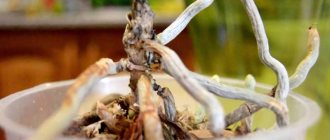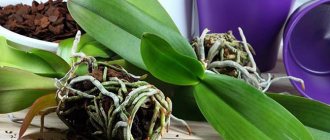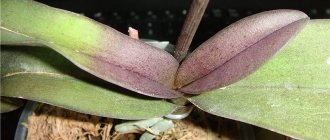What to do?
If the crop shows signs of fusarium wilt or a viral disease, then most likely it is impossible to save the plant. But trying to save culture is required in any case.
First, it’s worth determining the reason for the wilting of the plant’s foliage, it could be:
- overheating of roots due to sunlight, due to a heating battery;
- if you water the plant incorrectly, the substrate may become too wet or it has been dry for a long time;
- too much fertilizing leads to withering of the crop;
- caked, greasy substrate;
- incorrectly selected pot size;
- the appearance of pests;
- viral and fungal diseases.
{reklama}If spots appear on the foliage, any stains, pimples, or darkening are the result of an attack by pests or viral and fungal diseases.
Flowers fade for the following reasons:
- incorrect lighting;
- due to drafts;
- in the process of natural aging;
- due to the presence of food near food (for example, apples emit ethylene gas);
- orchids are too close to other plants.
You need to take out the orchid and carefully examine the roots.
You can understand that rot has appeared on the roots if:
- the rhizome has darkened;
- there are wet, oily, slimy places on the roots;
- they have become loose; when you press on the roots, liquid appears;
- they have become thinner, like threads;
- changed color from white, silver, greenish to brown or black.
Dry roots are easy to identify; this can happen due to improper watering or improper fertilizing.
Dry and rotten roots should be cut off with a sharp knife. It must be disinfected. The cut areas are sprinkled with crushed activated carbon and cinnamon powder. Then the roots are dried.
Attention! Trim the roots to healthy tissue.
If mold is visible on the substrate, it may be:
- due to increased humidity;
- due to insufficient light;
- lack of oxygen circulation in the substrate;
- old soil mixture;
- overly compacted or salty soil for orchids.
You can understand that the orchid was attacked by insects if:
- there are tubercles and spots on the foliage;
- leaves curl.
And lethargy, loss of foliage turgor, curling, falling of leaves and buds indicate that the roots are not in order.
Methods of resuscitation for diseases
If, as a result of improper location and lighting, the health of the orchid is at risk, the leaves have turned yellow, the roots have atrophied, then, first of all, they arrange a quarantine in the shade, the atrophied roots are cut off, the sections are rubbed with charcoal and watering is organized by immersion. After these procedures, the location of the flower is changed.
- If not properly cared for, fungal diseases occur and lumps form on yellowed leaves. Treatment is carried out with solutions of fungicides and sometimes by removing diseased parts of the flower.
- Bacterial stains. Usually, old leaves are affected, which must be removed and the sections treated with charcoal and bactericidal preparations.
- Root atrophy. The roots have dried out and are no longer able to perform their functions. Phalaenopsis resuscitation, for example, is carried out by division and transplantation. Urgently change care, temperature regime and location. It is also characterized by dried leaves.
- Putrefactive disease (root rots). Improper humidity, watering and temperature conditions can lead to this disease. The flower may look healthy for a long time, although putrefactive lesions are already developing. Resuscitation will help to save the orchid, which is carried out by cutting off the rotten parts and urgent transplantation with mandatory quarantine for a week.
How to revive a dying orchid?
Dying orchid
If the roots are damaged just a little, then you can dip them in a fungicide solution (Bordeaux mixture), then dry them and transplant the plant into another container with a new substrate.
If some roots have rotted, then you need to trim them back to healthy tissue. Then sprinkle the cuttings with coal and plant them in another pot with a new soil mixture.
If the roots are completely rotten, then it is worth cutting off all the roots and clearing the core of the stem to healthy tissue. Treat with an antiseptic (solution of brilliant green, iodine), dry. Sprinkle with Kornevin. Place the plant above a container of water so that the water does not reach the roots by 1.5-2 cm.
You can also use the Aksenova method.
Place a layer of expanded clay on the bottom of the container, then sphagnum moss and chopped bark. Water is poured so that it covers the expanded clay. And the trimmed plant is placed on top of the bark. All this is placed in a plastic bag or aquarium.
If the roots are damaged, the plant cannot be fertilized. Watering should be reduced. Place the orchid on a bright windowsill.
Pests
Pests are one of the most sensitive problems that can arise for a member of the orchid family, because it is very difficult to notice them with the naked eye in the first stages of damage. Usually their appearance is characterized by limp leaves.
- Scale insects. This type of parasite settles on the foliage, but due to the fact that it actively sucks the juices from them, the entire plant suffers. They look like small waxy tubercles that need to be treated with bactericidal preparations, after placing the orchid in quarantine.
- Whiteflies. Small white insects that lead to the loss of the leaf system, and with it the entire ability to photosynthesize, which can lead to the death of the roots and leaves of the entire flower. Before reviving an orchid, an urgent quarantine is carried out, since they easily move from plant to plant, and then they are treated with bactericidal preparations several times and washed with a solution of laundry soap.
- Scaleworms. Small white lumps that form on both sides of the foliage are also harmful to the metabolic processes of orchids, because they block the access of nutrients from one organ of the flower to another, absorbing them, which is why the orchid disappears. They are resuscitated, first of all, mechanically, and then treated with special drugs.
- Spider mites. These pests create a white coating on the surface of the leaf, like a cobweb, which harms photosynthesis and dries out the flower. Resuscitate with a solution of soapy water and bactericidal preparations.
- Powdery mildew. High air humidity and improper watering lead to the appearance of a white film on the surface of any part of the plant. Then sticky spots appear and the affected part dies.
How to revive an orchid in such cases? A solution of colloidal sulfur, after treatment with the drug, is quarantined.
Important! Any parasites and pests may not affect the orchid, but for this, the owner of the exotic plant must carefully monitor the appearance of the pet and any changes in it.
Temperature violation
In summer, the plant requires the air temperature in the room to be +22-25 degrees, and in winter +18-20 degrees.
If the air temperature is too high, the orchid must be placed in the shade, without feeding or watering. After 3-4 hours, lightly spray the plant with water. Then move it to a safe place.
If the air temperature is too low, the orchid is placed in a warmer place. Do not water or feed for some time. Wait until the plant adapts.
When attacked by pests, the plant is treated with Fitoverm.
Preventive measures
To prevent the death of plant parts, it is necessary to ensure the necessary balance of temperature and humidity, as well as:
- plant the orchid in a high-quality substrate made of pine bark, which will ensure air and moisture permeability of the roots;
- change the soil 2 times a year;
- check the plant for pests;
- control the concentration of fertilizers used.
We recommend that you find out what the composition should be and how to make your own soil for orchids.
Useful tips
To speed up the recovery of the plant, various additives can be used.
To moisten the substrate or watering use:
- sweet water (1 teaspoon of honey or sugar syrup per 1 liter of water);
- feeding with iron supplements;
- complex fertilizers in minimal concentration;
- treatment with growth stimulants (for example, “Zircon” or “Epin”), which are diluted in a concentration of 1 drop per 1 liter of water, and then the orchid is bathed in this solution for 20 minutes to 2 hours (depending on the condition of the flower).
The plant dies
Causes
Plants are sent to orchid paradise, as a rule, by “overly caring” gardeners who water their plants on a schedule, which should not be done. The combination of such watering with cool and too hot weather, as well as a lack of light, exhausts the orchid, it can suffocate and begin to rot or simply dry out.
There are three main reasons:
- lack of light;
- improper watering;
- lack of air.
Read more about the reasons for the death of orchids in this article.
First signs
any health problems with its entire appearance, namely:
- drooping leaves with weak turgor;
- lesions;
- rot;
- bad roots, etc.
Sometimes damage by such aggressive bacteria occurs that the flower can rot in just a few days , so it is extremely important to always monitor and care for your collection, as well as carry out preventive treatments.
You can learn more about the signs of an unhealthy plant here.
Answers to frequently asked questions
What conditions are necessary to prevent the leaves from becoming soft and limp?
Moderate watering, loose fertile soil, diffused sunlight and warmth.
Is it always possible to save damaged leaves?
No. In case of severe damage or frostbite, the leaf mass must be completely removed.
At what temperature should an orchid be grown?
The optimal temperature for the growth of this tropical crop is from 17° to 25°C.
The flower got stressed
Stress directly affects the condition of orchid leaves, making them lethargic. The plant gets used to certain living conditions and experiences difficulties in the process of adapting to a new place.
Examples of stressful situations: moving to a new place or frequently moving containers. In some cases, the plant recovers on its own. However, if the situation does not return to normal for a long time, then adaptation can be accelerated by creating a familiar habitat.
In addition, the orchid does not like having other tropical crops near it.
Natural growing conditions
It may seem incredible, but the orchid is easy to spot on any continent except Antarctica. Wherever some plants grow, the orchid survives. In suitable conditions it can grow up to 2 meters, and in places with harsh climates it grows covered in moss.
Australian orchids lead an underground lifestyle . Flowers do not appear on the surface at all, being pollinated by insects living in the soil.
In tropical forests, orchids crawl up trees, and in the mountains they cling to rocks, finding water in their cracks. It is also known that there are species of predatory orchids that feed on small insects caught on a flower.
The main feature of an orchid is its vitality. It forms aerial roots and thanks to this receives water from the roots and from the air.
Identification of the main cause of death
A change in the color of the roots does not always mean their death, because the color can be affected by the characteristics of the species, the composition of the soil, watering with hard water or violations in care regimes. But this sign is a signal for a thorough examination of the root system.
If the orchid grows in a transparent pot, then the roots are clearly visible, and the cause of the changes can be established quite easily. Otherwise, the plant must be removed from the vessel, first gently rocking it, freeing it from any remaining substrate and rinsing the roots with running water.
IMPORTANT! The appearance of the root system and analysis of care regimens will suggest possible causes of damage and death of the roots.
Among these reasons are:
- overheat;
- improper watering and fertilizing;
- poor lighting (darkening of roots);
- use of hard water (white deposits);
- inappropriate substrate;
- natural aging of the root.
Application of root growth stimulants
Zircon is used for plant resuscitation, as it helps to better build up the root mass , the plant adapts well and gains increased stress resistance.
Epin helps the rapid growth of roots, helps to increase the flower shoot, and increases the immunity of the orchid .
IMPORTANT ! The use of these drugs on the orchid will help it survive well in the post-resuscitation period.
Let's understand the problem
If a plant loses one leaf blade, then this is not a problem for it. But if the bush sheds all its leaves, then there is an obvious mistake in care and we need to figure it out so that this does not happen again. Reasons why a plant may lose its leaf mass:
- End of flowering period;
- Root system disease
IMPORTANT! Whatever the reason, it must be eliminated and the plant revived.
All that was left of the orchid were the roots.
What could be causing the drying out of the peduncle?
If the orchid peduncle begins to dry out, the reason for this may be the end of the flowering phase. However, the death of the peduncle can occur due to a deficiency of nutrients in the substrate and ill-organized care:
- Poor lighting . This is especially true in autumn, when daylight hours shorten. During this period, the peduncle may turn yellow and fade;
- Inappropriate temperatures . To ensure an optimal microclimate, you need to take care of the temperature regime, avoid hypothermia and protect the flower from overheating;
- Dry air . Excessive dryness in the room can also cause the peduncle to dry out. First, the plant will lose turgor, and then the buds on the peduncle will begin to dry out;
- Insufficient nutrition level . A lack of potassium, magnesium, boron or phosphorus in the substrate will also lead to the death of the peduncle.
When faced with drying out of the peduncle, it is important to quickly understand the cause of this undesirable phenomenon and begin to act.
Important! Drying peduncles must be removed after the flowering phase. Only in this case will the orchid be able to prepare for the next flowering cycle.











